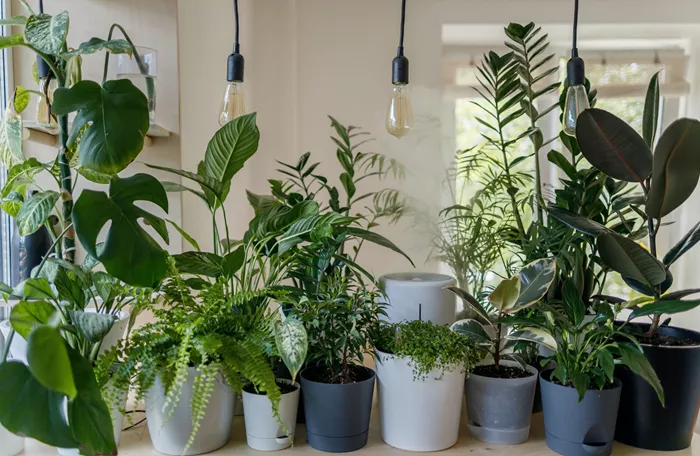Houseplants that thrive without much sunlight are perfect for brightening up shaded corners, apartments with limited windows, or offices. These plants adapt well to low-light conditions, requiring minimal care while adding lush greenery and improving indoor air quality. From elegant ferns to resilient succulents, many species flourish in dim environments, making them accessible for both novice and seasoned plant lovers.
Understanding Low-Light Houseplants
Low-light houseplants are those that can survive and grow well in areas with indirect, filtered, or minimal natural light. Unlike sun-loving plants, they do not need direct sunlight to photosynthesize effectively. Many originate from forest understories where sunlight is scarce but humidity is high, allowing them to adapt to indoor environments with limited light sources.
Top 15 Houseplants That Do Not Require a Lot of Sunlight
1. Pothos (Epipremnum aureum)
Known as “Devil’s Ivy,” pothos is almost indestructible and thrives in very low light conditions. Its trailing vines with heart-shaped leaves can brighten shelves or hang from baskets. It requires infrequent watering and tolerates artificial light, making it ideal for offices or rooms without windows.
2. Snake Plant (Sansevieria trifasciata)
Snake plants are among the easiest to grow and tolerate low light and drought. Their upright, sword-like leaves come in various patterns and colors. They need watering only when the soil is dry and can survive in dim corners, purifying the air as they grow.
3. ZZ Plant (Zamioculcas zamiifolia)
The ZZ plant has glossy, waxy leaves that store water, allowing it to withstand neglect and low light. It grows upright and compact, perfect for small spaces. It prefers light shade and low humidity but can adapt to darker rooms, though it is toxic to pets and children.
4. Chinese Evergreen (Aglaonema)
Chinese evergreens are valued for their variegated leaves and tolerance to low light and humidity. They require minimal watering and are slow growers, making them suitable for offices or homes with limited natural light.
5. Boston Fern (Nephrolepis exaltata)
Boston ferns thrive in indirect light and high humidity. They add lush greenery with their feathery fronds and are pet-friendly. They require regular misting and watering but can brighten bathrooms or shady spots.
6. Spider Plant (Chlorophytum comosum)
Spider plants are adaptable and flourish in low light. Their arching leaves and baby plantlets make them attractive hanging or tabletop plants. They require regular watering but tolerate occasional neglect.
7. Philodendron (Heartleaf and Xanadu varieties)
Philodendrons grow well in low light and are easy to maintain. The heartleaf variety is a trailing vine, while Xanadu is a bushier plant with glossy leaves. Both add tropical charm and require moderate watering.
8. Calathea
Calatheas are prized for their striking leaf patterns and colors. They prefer bright indirect to low light and high humidity. While a bit finicky, they reward care with bold foliage that folds at night, resembling praying hands.
9. English Ivy (Hedera helix)
English ivy adapts well to low light and high humidity environments, such as bathrooms. Its trailing vines can be trained on supports or allowed to cascade from hanging pots. It requires weekly watering and occasional pruning to control growth.
10. Cast Iron Plant (Aspidistra elatior)
True to its name, the cast iron plant is extremely hardy and tolerates low light, irregular watering, and neglect. Its broad, dark green leaves add a classic look and it grows slowly, making it ideal for beginners.
11. Dracaena (Corn Plant and Madagascar Dragon Tree)
Dracaenas are versatile with striking foliage in various colors and patterns. They tolerate low light but prefer indirect light. These plants can grow tall, making them excellent for corners or entryways. They require moderate watering and occasional pruning.
12. Prayer Plant (Maranta leuconeura)
Prayer plants have beautifully patterned leaves that fold at night. They thrive in low to medium light and prefer warm, humid conditions. They need regular watering and humidity but add vibrant color to shaded spaces.
13. Hoya (Wax Plant)
Hoya plants prefer indirect light and high humidity. Their thick, waxy leaves and clusters of star-shaped flowers add interest. They are low maintenance, requiring watering every 7-10 days and occasional fertilizing.
14. Mistletoe Cactus (Rhipsalis baccifera)
Unlike most cacti, mistletoe cactus tolerates low light and thrives in indirect light. Its long succulent stems and small white berries make it an unusual and decorative choice for shady shelves.
15. Yucca Cane (Yucca gigantea)
Yucca cane is hardy and adaptable, tolerating low light and drought. It grows tall with sword-like leaves and prefers well-drained soil. It can be toxic to pets, so placement should be considered carefully.
Care Tips for Low-Light Houseplants
Watering: Plants in low light generally require less water. Allow the soil to dry out between watering to prevent root rot.
Humidity: Many low-light plants originate from tropical environments and benefit from higher humidity. Mist leaves or use pebble trays to increase moisture.
Fertilizing: Limit fertilization during low light periods since plants grow slower and need fewer nutrients.
Rotation: Turn plants regularly to ensure even light exposure on all sides and prevent leaning.
Supplemental Lighting: If natural light is insufficient, consider grow lights or spotlights to enhance growth and health.
Conclusion
Low-light houseplants offer a wonderful way to bring life and greenery into spaces with limited sunlight. Their adaptability and diverse forms—from trailing vines to stately palms—make them suitable for nearly any indoor environment. With minimal care and the right species, even the shadiest corners of your home or office can flourish with vibrant, healthy plants. Choosing the right low-light plants not only enhances aesthetics but also improves air quality and well-being, making them a valuable addition to everyday living.


